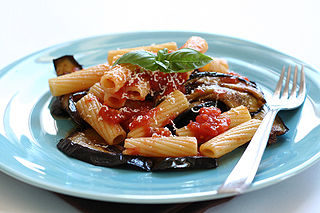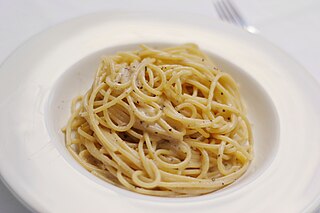
Spaghetti is a long, thin, solid, cylindrical pasta. It is a staple food of traditional Italian cuisine. Like other pasta, spaghetti is made of milled wheat, water, and sometimes enriched with vitamins and minerals. Italian spaghetti is typically made from durum-wheat semolina. Usually the pasta is white because refined flour is used, but whole wheat flour may be added. Spaghettoni is a thicker form of spaghetti, while spaghettini is a thinner form. Capellini is a very thin spaghetti, while vermicelli refers to intermediate widths, varying between the United States and Italy.

Tomato sauce can refer to many different sauces made primarily from tomatoes, usually to be served as part of a dish, rather than as a condiment. Tomato sauces are common for meat and vegetables, but they are perhaps best known as bases for sauces for Mexican salsas and Italian pasta dishes. Tomatoes have a rich flavor, high water content, soft flesh which breaks down easily, and the right composition to thicken into a sauce when stewed, without the need for thickeners such as roux or masa. All of these qualities make them ideal for simple and appealing sauces.

Lasagna is a type of pasta, possibly one of the oldest types, made of very wide, flat sheets. Either term can refer to an Italian dish made of stacked layers of lasagna alternating with fillings such as ragù, béchamel sauce, vegetables, cheeses, and seasonings and spices. The dish may be topped with grated cheese, which becomes melted during baking. Typically cooked pasta is assembled with the other ingredients and then baked in an oven. The resulting baked pasta is cut into single-serving square or rectangular portions.

Carbonara is a pasta dish made with eggs, hard cheese, fatty cured pork, and black pepper. It is typical of the Lazio region of Italy. The dish took its modern form and name in the middle of the 20th century.

Penne alla vodka is a pasta dish made primarily with vodka and penne, usually accompanied with heavy cream, crushed tomatoes or tomato sauce, onions, and sometimes small meats and vegetables such as sausage, pancetta or peas. The alcohol is said to intensify and accentuate flavors in the dish.

Pasta al pomodoro is an Italian food typically prepared with pasta, olive oil, fresh tomatoes, basil, and various other fresh ingredients. It is intended to be a quick and light dish, rather than a dish in a heavy sauce.

Arrabbiata sauce, known in Italian as sugo all'arrabbiata, is a spicy sauce for pasta made from garlic, tomatoes, and dried red chili peppers cooked in olive oil. The sauce originates from the Lazio region of Italy, and particularly from the city of Rome.

Spaghetti alla puttanesca is a pasta dish invented in Naples in the mid-20th century and made typically with tomatoes, olive oil, olives, anchovies, chili peppers, capers and garlic, with vermicelli or spaghetti.

Coda alla vaccinara is an oxtail stew in modern Roman cuisine including various vegetables, notably celery. The tail is considered offal, nicknamed in Rome the quinto quarto.

Sugo all'amatriciana or alla matriciana, also known as salsa all'amatriciana, is a traditional Italian pasta sauce based on guanciale, pecorino romano cheese, tomato, and, in some variations, onion. Originating from the comune (municipality) of Amatrice, the amatriciana is one of the best known pasta sauces in present-day Roman and Italian cuisine. The Italian government has named it a traditional agro-alimentary product of Lazio and amatriciana tradizionale is registered as a traditional speciality guaranteed (TSG) in the EU and the UK.

Guanciale is an Italian salt-cured meat product prepared from pork jowl or cheeks. Its name is derived from guancia, 'cheek'. Its rendered fat gives flavor to and thickens the sauce of pasta dishes.

Neapolitan cuisine has ancient historical roots that date back to the Greco-Roman period, which was enriched over the centuries by the influence of the different cultures that controlled Naples and its kingdoms, such as that of Aragon and France.

Marinara sauce is a tomato sauce usually made with tomatoes, garlic, herbs, and onions. Variations include capers, olives, spices, and a dash of wine. Widely used in Italian-American cuisine, it is known as alla marinara in Italy, where it is typically made with tomatoes, basil, olive oil, garlic and oregano, but also sometimes olives, capers, and salted anchovies. It is used for spaghetti and vermicelli, but also with meat or fish.

Roman cuisine comes from the Italian city of Rome. It features fresh, seasonal and simply-prepared ingredients from the Roman Campagna. These include peas, globe artichokes and fava beans, shellfish, milk-fed lamb and goat, and cheeses such as pecorino romano and ricotta. Olive oil is used mostly to dress raw vegetables, while strutto and fat from prosciutto are preferred for frying. The most popular sweets in Rome are small individual pastries called pasticcini, gelato and handmade chocolates and candies. Special dishes are often reserved for different days of the week; for example, gnocchi is eaten on Thursdays, baccalà on Fridays, and trippa on Saturdays.

Pasta alla Norma, earlier called pasta con le melanzane, is an Italian dish of pasta and eggplant. It is typical of Sicilian cuisine, from Catania in particular.

Cacio e pepe is a pasta dish typical of the Lazio region of Italy. Cacio e pepe means 'cheese and pepper' in several central Italian dialects. In keeping with its name, the dish contains grated pecorino romano and black pepper, together with tonnarelli or spaghetti. All the ingredients keep well for a long time, which made the dish practical for shepherds without fixed abode. Rough-surfaced pasta is recommended to make the sauce adhere well.

Abbacchio is an Italian preparation of lamb typical of the Roman cuisine. It is consumed throughout central Italy as an Easter and Christmas dish. Abbacchio is a product protected by the European Union with the PGI mark.
















